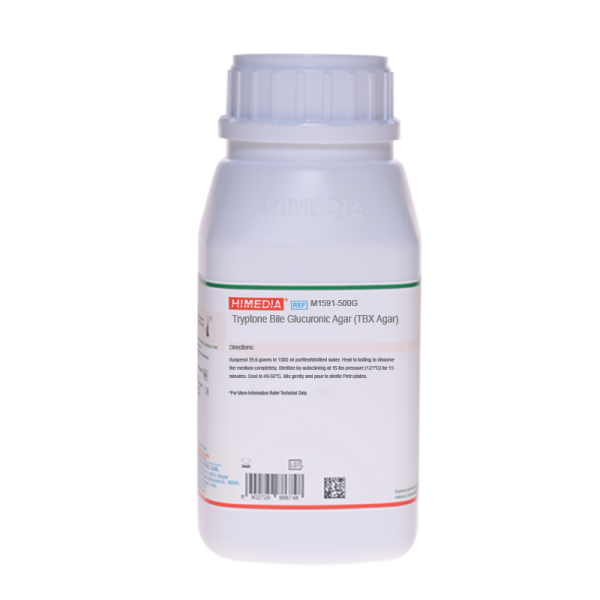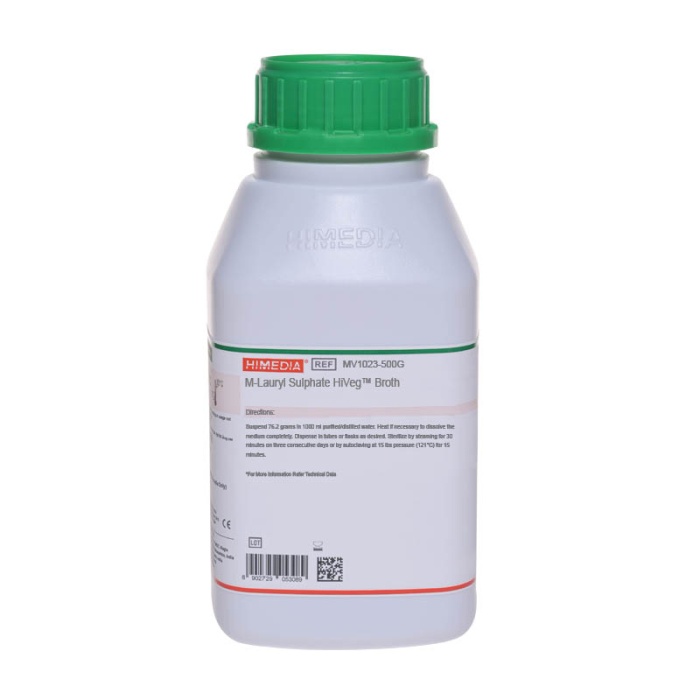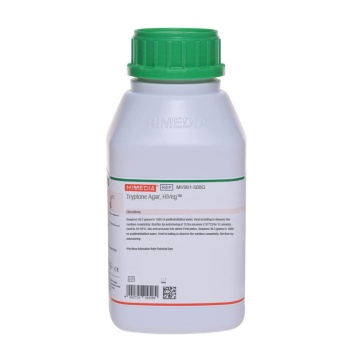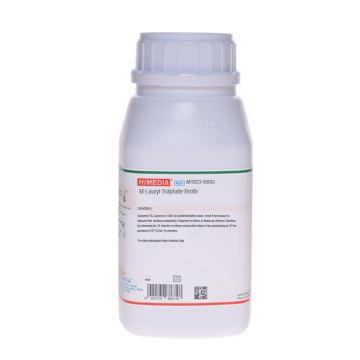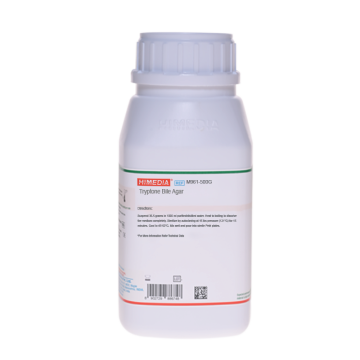 Your enquiry has been submitted
Your enquiry has been submitted
Tryptone Bile Glucuronic Agar
Intended Use
Recommended for the detection and enumeration of Escherichia coli in foodstuffs, animal feed, water and clinical samples without further confirmation on membrane filter or by indole reagent. The composition and performance of this media are as per specifications laid down in ISO 16649-2:2001 and ISO 11133:2014 (E) /Amd.:2020.
Composition
| Ingredients | g / L |
|---|---|
| Tryptone | 20.000 |
| Bile salts mixture | 1.500 |
| X-ß-D-glucoronic acid | 0.075 |
| Dimethyl sulfoxide | 3.000 |
| Agar | 15.000 |
Final pH (at 25°C): 7.2±0.2
Formula adjusted, standardized to suit performance parameters
Directions
Suspend 39.6 grams in 1000 ml purified/distilled water. Heat to boiling to dissolve the medium completely. Sterilize by autoclaving at 15 lbs pressure (121°C) for 15 minutes. Cool to 45-50°C. Mix well and pour in sterile Petri plates.
Principle And Interpretation
Tryptone Bile Agar is to detect Escherichia coli in foods (1), where recovery of E.coli is faster, more reliable and accurate. Most of the E.coli strains can be differentiated from other coliforms by the presence of enzyme glucuronidase, which is highly specific for E.coli (2). The chromogenic agent X-glucuronide used in this medium helps to detect glucuronidase activity of E.coli. E.coli cells absorb X-glucuronide and the intracellular glucuronidase enzyme splits the bond between the chromophore and the glucuronide. The released chromophore gives bluish green colouration to the E.coli colonies. The formulation is in accordance with ISO 16649-2 (3,4) and performance of this media are as per specifications laid down in ISO 11133 (5). It can also be used to isolate E.coli from clinical samples.
Tryptone provides carbon, nitrogen compounds, long chain amino acids, vitamins and other essential growth nutrients to the organisms. Bile salts mixture inhibits gram-positive organisms. The surface of the plated medium is dried before use. Dilute food samples 1:5 or 1:10 with 0.1% (w/v) sterile Peptone Water (M028) and homogenize in a blender or a stomacher. Pipette 0.5 ml or 1.0 ml of the homogenized food sample on to the plate and spread with sterile glass spreader. Incubate the plates at 30°C for 4 hours and then at 44°C for 18 hours.
Type of specimen
Clinical samples - urine, Food samples ; Water samples
Specimen Collection and Handling
For clinical samples follow appropriate techniques for handling specimens as per established guidelines (6,7).
For food samples, follow appropriate techniques for sample collection and processing as per guidelines (3-5).
For water samples, follow appropriate techniques for sample collection, processing as per guidelines and local standards (8).
After use, contaminated materials must be sterilized by autoclaving before discarding.
Warning and Precautions
In Vitro diagnostic use. For professional use only. Read the label before opening the container. Wear protective gloves/protective clothing/eye protection/ face protection. Follow good microbiological lab practices while handling specimens and culture. Standard precautions as per established guidelines should be followed while handling clinical specimens. Safety guidelines may be referred in individual safety data sheets.
Limitations
- ß-glucuronidase is present in 97% of E.coli strains, however few E.coli may be negative.
- Certain species of Salmonella are ß-glucuronidase positive.
- Individual organisms differ in their growth requirement and may show variable growth patterns on the medium.
- Each lot of the medium has been tested for the organisms specified on the COA. It is recommended to users to validate the medium for any specific microorganism other than mentioned in the COA based on the user’s unique requirement.
Performance and Evaluation
Performance of the medium is expected when used as per the direction on the label within the expiry period when stored at recommended temperature.
Quality Control
Appearance: Cream to yellow homogeneous free flowing powder
Gelling: Firm, comparable with 1.5% Agar gel
Colour and Clarity of prepared medium: Light yellow coloured, clear to slightly opalescent gel forms in Petri plates
Reaction: Reaction of 3.96% w/v aqueous solution at 25°C. pH : 7.2±0.2
pH: 7.00-7.40
Cultural Response
Productivity: Cultural characteristics observed after an incubation at 44±1°C for 21±3 hours. Recovery rate is considered as 100% for bacteria growth on Reference Medium - Soyabean Casein Digest Agar (Tryptone Soya Agar).
Specificity: Cultural characteristics observed after an incubation at 44±1°C for 21±3 hours.
Selectivity: Cultural characteristics observed after an incubation at 44±1°C for 21±3 hours.
| Organism | Inoculum (CFU) | Growth | Recovery | Colour of Colony |
|---|---|---|---|---|
| Escherichia coli ATCC 25922 (00013*) | 50-100 | luxuriant | >=50% | Blue |
| Escherichia coli ATCC 8739 (00012*) | 50-100 | luxuriant | >=50% | Blue |
| Escherichia coli NCTC 13216 (00202*) | 50-100 | luxuriant | >=50% | Blue |
| Specificity | ||||
| Citrobacter freundii ATCC 43864 (00006*) | 103-104 | luxuriant | White to green-beige | |
| Pseudomonas aeruginosa ATCC 27853 (00025*) | 103-104 | luxuriant | White to green-beige | |
| Selectivity | ||||
| Enterococcus faecalis ATCC 19433 (00009*) | >=104 | inhibited | ||
| Enterococcus faecalis ATCC 29212 (00087*) | >=104 | inhibited | ||
Key : *Corresponding WDCM numbers.
Storage and Shelf Life
Store between 15-25°C in a tightly closed container and the prepared medium at 2-8°C. Use before expiry date on the label. On opening, product should be properly stored dry, after tightly capping the bottle in order to prevent lump formation due to the hygroscopic nature of the product. Improper storage of the product may lead to lump formation. Store in dry ventilated area protected from extremes of temperature and sources of ignition. Seal the container tightly after use. Product performance is best if used within stated expiry period.
Disposal
User must ensure safe disposal by autoclaving and/or incineration of used or unusable preparations of this product. Follow established laboratory procedures in disposing of infectious materials and material that comes into contact with clinical sample must be decontaminated and disposed of in accordance with current laboratory techniques (6,7).
Reference
- Anderson J.M. and Baird-Parker A.C., (1975), J. Appl. Bact., 39:111.
- Hansen W. and Yourassawsky E.,(1984), J.Clin. Microbiol., 20:1177.
- Microbiology of the food chain , Horizontal method for the enumeration of beta-glucuronidase-positive Escherichia coli Part 1: Colony-count technique at 44 degrees C using membranes and 5-bromo-4-chloro-3-indolyl beta-D-glucuronide International Standard ISO 16649-1: 2001.
- Microbiology of food and animal feeding stuffs- Horizontal method for the enumeration of ß-glucuronidase-positive Escherichia coli. International Standard ISO 16649-2: 1999.
- Microbiology of food, animal feeding stuffs and water- Preparation production, storage and performance testing of culture media, ISO 11133:2014 (E) & Amd :2020.
- Isenberg, H.D. Clinical Microbiology Procedures Handbook. 2nd Edition
- Jorgensen,J.H., Pfaller , M.A., Carroll, K.C., Funke, G., Landry, M.L., Richter, S.S and Warnock., D.W. (2015) Manual of Clinical Microbiology, 11th Edition. Vol. 1.
- Lipps WC, Braun-Howland EB, Baxter TE,eds. Standard methods for the Examination of Water and Wastewater, 24th ed. Washington DC:APHA Press; 2023.
| Product Name | Tryptone Bile Glucuronic Agar |
|---|---|
| SKU | M1591 |
| Product Type | Regular |
| Physical Form | Powder |
| Origin | Animal |
| Packaging type | HDPE |
| References | 1.Frampton E W, Restaino L, Blaszko L.198 |
| Customized Product Available | No |



